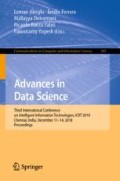Abstract
Emojis are pictographs which provide emotional cues and creativity to an otherwise bland textual conversation. They are widely used across different social media platforms to express ineffable feelings and facilitate an intimate conversation. The extent of its popularity can be gauged from the growing number of emojis in upcoming Emoji version. However, prior works on emoji prediction have majorly emphasized semantic relatedness. In this paper, we attempt to understand the significance of visual similarity and thus, the contribution of visual features in computing similarity of emojis. We use a publicly available dataset EmoSim508 to perform our experiments. The results indicate a correlation between visual features and emoji similarity.
Access this chapter
Tax calculation will be finalised at checkout
Purchases are for personal use only
Notes
- 1.
- 2.
https://goo.gl/BdN1L1 accessed on March 20, 2018.
- 3.
https://goo.gl/z8bex5 accessed on March 20, 2018.
- 4.
References
Pohl, H., Murray-Smith, R.: Focused and casual interactions: allowing users to vary their level of engagement. In: Proceedings of the SIGCHI Conference on Human Factors in Computing Systems, pp. 2223–2232. ACM (2013)
Janssen, J.H., Ijsselsteijn, W.A., Westerink, J.H.D.M.: How affective technologies can influence intimate interactions and improve social connectedness. Int. J. Hum. Comput. Stud. 72(1), 33–43 (2014)
Cho, H., Ishida, T.: Exploring cultural differences in pictogram interpretations. In: Ishida, T. (ed.) The Language Grid. Cognitive Technologies, pp. 133–148. Springer, Heidelberg (2011). https://doi.org/10.1007/978-3-642-21178-2_9
Miller, H., Kluver, D., Thebault-Spieker, J., Terveen, L., Hecht, B.: Understanding emoji ambiguity in context: the role of text in emoji-related miscommunication. In: 11th International Conference on Web and Social Media, ICWSM 2017. AAAI Press (2017)
Pohl, H., Domin, C., Rohs, M.: Beyond just text: semantic emoji similarity modeling to support expressive communication. ACM Trans. Comput. Hum. Interact. (TOCHI) 24(1), 6 (2017)
Barbieri, F., Ronzano, F., Saggion, H.: What does this emoji mean? A vector space skip-gram model for twitter emojis. In: LREC (2016)
Eisner, B., Rocktäschel, T., Augenstein, I., Bošnjak, M., Riedel, S.: Emoji2vec: learning emoji representations from their description (2016). arXiv preprint: arXiv:1609.08359
Wijeratne, S., Balasuriya, L., Sheth, A., Doran, D.: A semantics-based measure of emoji similarity (2017). arXiv preprint: arXiv:1707.04653
Hess, R.: An open-source siftlibrary. In: Proceedings of the 18th ACM International Conference on Multimedia, pp. 1493–1496. ACM (2010)
Bradski, G., Kaehler, A.: Opencv. Dr. Dobbs. J. Softw. Tools 3, 122–125 (2000)
Kelly, R., Watts, L.: Characterising the inventive appropriation of emoji as relationally meaningful in mediated close personal relationships. In: Experiences of Technology Appropriation: Unanticipated Users, Usage, Circumstances, and Design (2015)
Pavalanathan, U., Eisenstein, J.: More emojis, less :) the competition for paralinguistic function in microblog writing. First Monday 21(11) (2016). https://doi.org/10.5210/fm.v21i11.6879, https://firstmonday.org/ojs/index.php/fm/article/view/6879/5647. Accessed 16 Nov. 2018, ISSN 13960466
Ai, W., Lu, X., Liu, X., Wang, N., Huang, G., Mei, Q.: Untangling emoji popularity through semantic embeddings. In: ICWSM, pp. 2–11 (2017)
Wijeratne, S., Balasuriya, L., Sheth, A., Doran, D.: EmojiNet: building a machine readable sense inventory for emoji. In: Spiro, E., Ahn, Y.-Y. (eds.) SocInfo 2016, Part I. LNCS, vol. 10046, pp. 527–541. Springer, Cham (2016). https://doi.org/10.1007/978-3-319-47880-7_33
Lowe, D.G.: Object recognition from local scale-invariant features. In: Proceedings of the seventh IEEE International Conference on Computer Vision, vol. 2, pp. 1150–1157. IEEE (1999)
Lowe, D.G.: Distinctive image features from scale-invariant keypoints. Int. J. Comput. Vis. 60(2), 91–110 (2004)
Author information
Authors and Affiliations
Corresponding author
Editor information
Editors and Affiliations
Rights and permissions
Copyright information
© 2019 Springer Nature Singapore Pte Ltd.
About this paper
Cite this paper
Rai, S., Garg, A., Chakraverty, S. (2019). Understanding the Role of Visual Features in Emoji Similarity. In: Akoglu, L., Ferrara, E., Deivamani, M., Baeza-Yates, R., Yogesh, P. (eds) Advances in Data Science. ICIIT 2018. Communications in Computer and Information Science, vol 941. Springer, Singapore. https://doi.org/10.1007/978-981-13-3582-2_7
Download citation
DOI: https://doi.org/10.1007/978-981-13-3582-2_7
Published:
Publisher Name: Springer, Singapore
Print ISBN: 978-981-13-3581-5
Online ISBN: 978-981-13-3582-2
eBook Packages: Computer ScienceComputer Science (R0)

